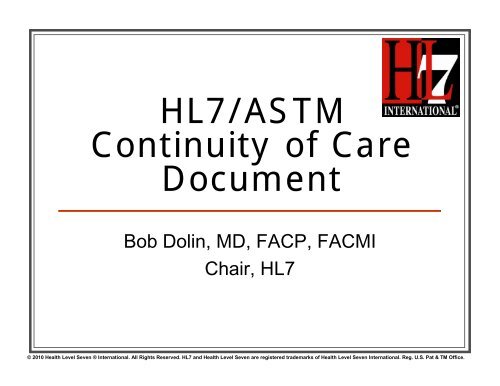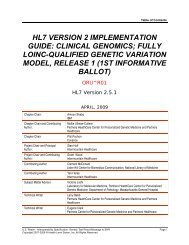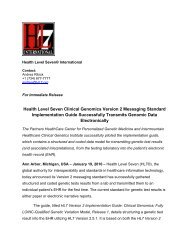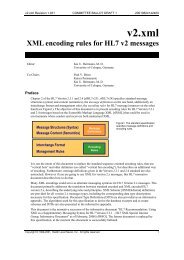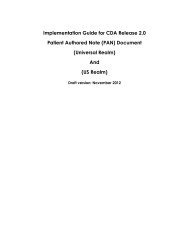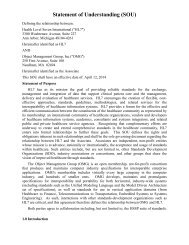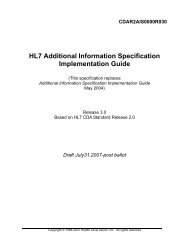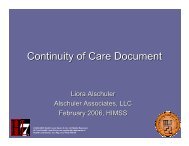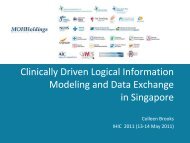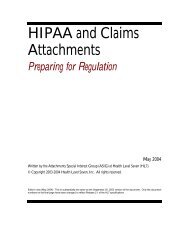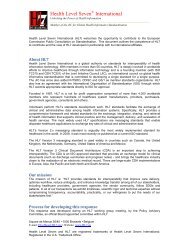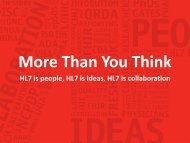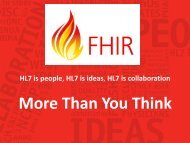HL7/ASTM Continuity of Care Document
HL7/ASTM Continuity of Care Document
HL7/ASTM Continuity of Care Document
Create successful ePaper yourself
Turn your PDF publications into a flip-book with our unique Google optimized e-Paper software.
<strong>HL7</strong>/<strong>ASTM</strong><br />
<strong>Continuity</strong> <strong>of</strong> <strong>Care</strong><br />
<strong>Document</strong><br />
Bob Dolin, MD, FACP, FACMI<br />
Chair, <strong>HL7</strong><br />
© 2010 Health Level Seven ® International. All Rights Reserved. <strong>HL7</strong> and Health Level Seven are registered trademarks <strong>of</strong> Health Level Seven International. Reg. U.S. Pat & TM Office.
CDA is based on a principle <strong>of</strong><br />
Incremental Interoperability<br />
• Incremental Interoperability means that an implementer can begin<br />
with a simple CDA, and then add structured data elements over time.<br />
• CDA R2 consists <strong>of</strong> a single CDA XML Schema, and<br />
the “architecture” arises from the ability to apply one or<br />
more “templates” which serve to constrain the richness and flexibility<br />
<strong>of</strong> CDA.<br />
• Pr<strong>of</strong>essional society recommendations, national clinical practice<br />
guidelines, standardized data sets can be expressed as CDA<br />
templates.<br />
• There are many kinds <strong>of</strong> templates that might be<br />
created. Two are particularly relevant for documents:<br />
‣ Those that constrain the document sections based on the type <strong>of</strong> document (sectionlevel<br />
templates);<br />
‣ Those that constrain the entries within document sections (entry-level templates).<br />
© 2010 Health Level Seven ® International. All Rights Reserved. <strong>HL7</strong> and Health Level Seven are registered trademarks <strong>of</strong> Health Level Seven International. Reg. U.S. Pat & TM Office.
<strong>ASTM</strong> CCR vs. <strong>HL7</strong> CDA<br />
• What if you could have both?!? (or, what if you could have<br />
your data elements, and send them in a common<br />
exchange framework too?)<br />
© 2010 Health Level Seven ® International. All Rights Reserved. <strong>HL7</strong> and Health Level Seven are registered trademarks <strong>of</strong> Health Level Seven International. Reg. U.S. Pat & TM Office.
<strong>ASTM</strong> CCR + <strong>HL7</strong> CDA = CCD<br />
• The primary use case for the <strong>ASTM</strong> CCR is to provide a snapshot in<br />
time containing a summary <strong>of</strong> the pertinent clinical, demographic, and<br />
administrative data for a specific patient.<br />
• From the perspective <strong>of</strong> CDA, the <strong>ASTM</strong> CCR is a standardized data<br />
set that can be used to constrain CDA specifically for summary<br />
documents.<br />
• The resulting specification is known as the <strong>Continuity</strong> <strong>of</strong> <strong>Care</strong><br />
<strong>Document</strong> (CCD).<br />
© 2010 Health Level Seven ® International. All Rights Reserved. <strong>HL7</strong> and Health Level Seven are registered trademarks <strong>of</strong> Health Level Seven International. Reg. U.S. Pat & TM Office.
<strong>Continuity</strong> <strong>of</strong> <strong>Care</strong> <strong>Document</strong> (CCD)<br />
• CCD maps the CCR elements into a CDA representation.<br />
<br />
<br />
<br />
2.16.840.1.113883.19.1<br />
<br />
<br />
<br />
Assessment Time<br />
<br />
<br />
200004071430<br />
<br />
<br />
<br />
Hematology<br />
<br />
<br />
CBC WO DIFFERENTIAL<br />
<br />
43789009<br />
SNOMED CT<br />
<br />
<br />
Final Results<br />
<br />
<strong>Continuity</strong> <strong>of</strong> <strong>Care</strong> <strong>Document</strong> (CCD)<br />
• CCD sections include:<br />
‣ Payers<br />
‣ Advance Directives<br />
‣ Support<br />
‣ Functional Status<br />
‣ Problems<br />
‣ Family History<br />
‣ Social History<br />
‣ Alerts (e.g. Allergies, Adverse Events)<br />
‣ Medications<br />
‣ Medical Equipment<br />
‣ Immunizations<br />
‣ Vital Signs<br />
‣ Results<br />
‣ Procedures<br />
‣ Encounters<br />
‣ Plan <strong>of</strong> <strong>Care</strong><br />
© 2010 Health Level Seven ® International. All Rights Reserved. <strong>HL7</strong> and Health Level Seven are registered trademarks <strong>of</strong> Health Level Seven International. Reg. U.S. Pat & TM Office.
National Health Data Repository<br />
• This scenario has been built in collaboration<br />
with the <strong>HL7</strong> Medical Records committee,<br />
and shows how a combination <strong>of</strong> <strong>HL7</strong><br />
messages (or IHE XDS) and CDA<br />
documents can support the requirements <strong>of</strong><br />
a National Health Data Repository.<br />
© 2010 Health Level Seven ® International. All Rights Reserved. <strong>HL7</strong> and Health Level Seven are registered trademarks <strong>of</strong> Health Level Seven International. Reg. U.S. Pat & TM Office.
National Health Data Repository<br />
VA New Orleans National Repository VA Houston<br />
1. (Event)<br />
2. (Query)<br />
3. (Response)<br />
4. (Query)<br />
5. (Response)<br />
6. (Event)<br />
1. PatientOne receives his care at the VA New Orleans, which stores data in a local EHR, and<br />
contributes clinical documents to a national health data repository, which contains all clinical<br />
data that exists throughout the national VA health care system.<br />
2. Due to Hurricane Katrina, PatientOne drives his family to Houston to stay with relatives,<br />
leaving their belongings behind. In Houston, PatientOne starts experiencing chest pain, and<br />
he is taken to the VA Houston ER. NurseOne asks the patient to provide his Veteran<br />
Information Card (VIC), finds no data in the local system, and submits a query for<br />
information about PatientOne to the National Repository.<br />
3. The National Repository sends a response back, containing a listing <strong>of</strong> all clinical documents<br />
identified for PatientOne.<br />
© 2010 Health Level Seven ® International. All Rights Reserved. <strong>HL7</strong> and Health Level Seven are registered trademarks <strong>of</strong> Health Level Seven International. Reg. U.S. Pat & TM Office.
National Health Data Repository<br />
VA New Orleans National Repository VA Houston<br />
1. (Event)<br />
2. (Query)<br />
3. (Response)<br />
4. (Query)<br />
5. (Response)<br />
6. (Event)<br />
4. NurseOne finds a recent CCD, several progress note documents, and recent reports <strong>of</strong> a<br />
treadmill and coronary angiogram, and submits a query to the National Repository for the<br />
documents <strong>of</strong> interest.<br />
5. The National Repository responds back with the requested documents. Once the documents<br />
are available, they can be viewed in the local system.<br />
6. Meanwhile, PhysicianOne has begun evaluating PatientOne. Sublingual NTG and O2 have<br />
been applied, and chest pain has resolved. An ECG is normal. PhysicianOne reviews the<br />
coronary angiogram report, which found no evidence <strong>of</strong> coronary artery disease.<br />
PhysicianOne reviews the CCD, which includes a history <strong>of</strong> GERD. PatientOne is diagnosed<br />
with GERD, reassured, and discharged. PhysicianOne then enters an ER visit note into the<br />
local system. When the visit note is completed and signed, a copy <strong>of</strong> it is uploaded to the<br />
National Repository.<br />
© 2010 Health Level Seven ® International. All Rights Reserved. <strong>HL7</strong> and Health Level Seven are registered trademarks <strong>of</strong> Health Level Seven International. Reg. U.S. Pat & TM Office.
CCD and Medication Reconciliation<br />
• Henry Levin the 7th is a 75 year old male with type 2 DM, CAD,<br />
stage 2 CKD, and LV diastolic dysfunction. He is admitted to hospital on Jan<br />
12, 2007, with fever, volume depletion, left lower extremity cellulitis, and<br />
increase in baseline serum creatinine. At the time <strong>of</strong> admission, his clinician<br />
obtains medication information from a pharmacy application and from the<br />
patient’s personal health record (PHR), both in CCD format.<br />
© 2010 Health Level Seven ® International. All Rights Reserved. <strong>HL7</strong> and Health Level Seven are registered trademarks <strong>of</strong> Health Level Seven International. Reg. U.S. Pat & TM Office.
CCD and Medication Reconciliation<br />
• During the hospitalization,<br />
medications are adjusted.<br />
Intravenous clindamycin is<br />
administered. Fever and<br />
cellulitis improve and serum<br />
creatinine returns to<br />
baseline. He is transferred<br />
to a skilled nursing facility<br />
(SNF) on Jan 15, 2007 to<br />
complete a course <strong>of</strong><br />
intravenous antibiotics. A<br />
CCD accompanies –<br />
containing a section for<br />
medications on admission<br />
and a section for ongoing<br />
medication orders.<br />
© 2010 Health Level Seven ® International. All Rights Reserved. <strong>HL7</strong> and Health Level Seven are registered trademarks <strong>of</strong> Health Level Seven International. Reg. U.S. Pat & TM Office.


